Things you should know for apartment development
When it comes to property development, there's nothing more exciting than creating a brand new apartment building from scratch. No matter if you're new to the game, you can always make a good start. Here is everything you need to know about developing apartments, from finding the right location to securing funding and marketing your finished product.
Explore some tips on how to maximise your return on investment. So whether you're a seasoned developer or an investor just looking to get into the market, this guide is for you!
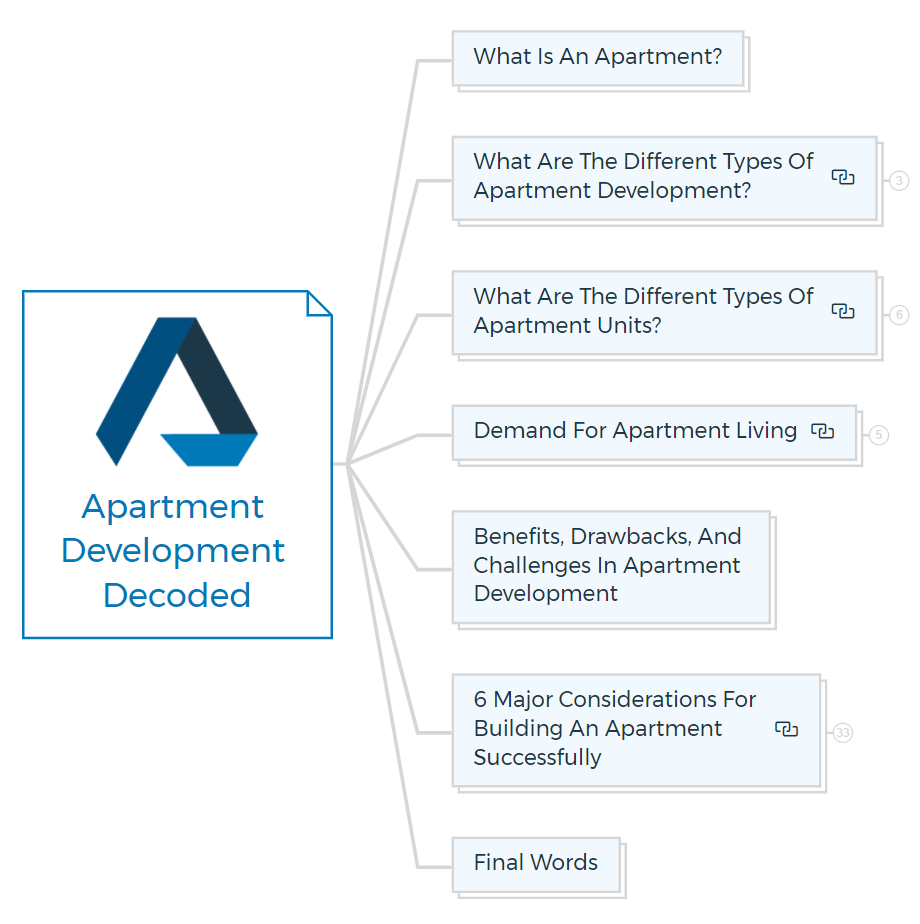
What is an apartment?
Apartments are the most popular housing space, especially in cities. The phrase refers to any residential unit within a building. It is a solitary living area among several others within the same building.
It can be anything from a single-family home to a townhouse, a large residential building, or even high-rise condominiums.
Types of apartment development
Apartment developments are of two types: urban and holiday. The accommodation and size of these flats may vary depending on the target market, but the essential elements will be identical.
An apartment complex is simply a structure with five or more housing units on various floor levels, and it can be further classified as follows:
- Low-rise: A system with two to three stories and no elevators.
- Mid-rise: Three to eight stories with elevators.
- High-rise: A system having more than eight stories and elevators.
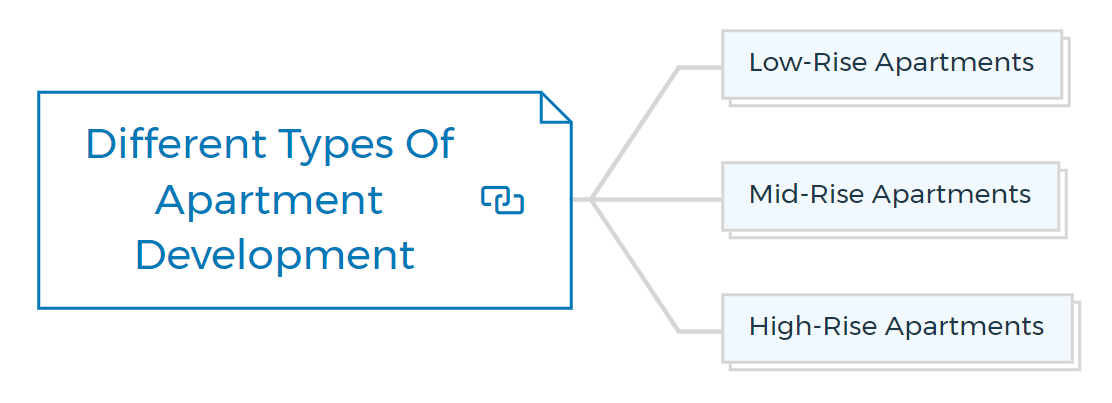
Low-rise apartments
You will typically find low-rise apartment complexes in the suburbs, where density regulation is less restrictive than in the city centre. They're also known as three-story walk-ups because they don't have elevators.
A low-rise apartment building's structural system discipline is less stringent than a mid- or high-rise building, allowing for more design flexibility.
Furthermore, the building codes are significantly more lenient, especially for fireproofing. Parking is often available 'on grade' at ground level, which is less expensive than parking in a basement.
Mid-rise apartments
Buildings of up to eight stories are known as mid-rise apartments. You can determine the height by the length of a fire-engine ladder, which measures 24 metres. Any building above this height requires sprinklers, which adds to the developer's costs.
These structures, ranging from five to eight stories, are constructed in the suburbs near the CBD or on TOD sites. An apartment in a mid-rise building is less flexible than one in a low-rise due to the greater loads.
High-rise apartments
The structural system, which is primarily concrete or steel frame, limits the design of a high-rise apartment building, and the vertical lift core plays a significant role.
The high-rise apartment's sheer repetition necessitates a high level of architectural rigour, which means that, with a few exceptions, all apartment levels are identical.
You will find such high-density residential developments in the CBD, offering larger plot ratios and fewer parking constraints. From studio apartments to penthouses on the top levels, high-rise apartments often offer a wide range of accommodations.
Mixed-use development can also include high-rise apartments with retail, commercial, or restaurant space on the ground and first floors.
What are the different types of apartment units?
Apartment units can be classified or designed into the following segments, depending on their location and market demands:
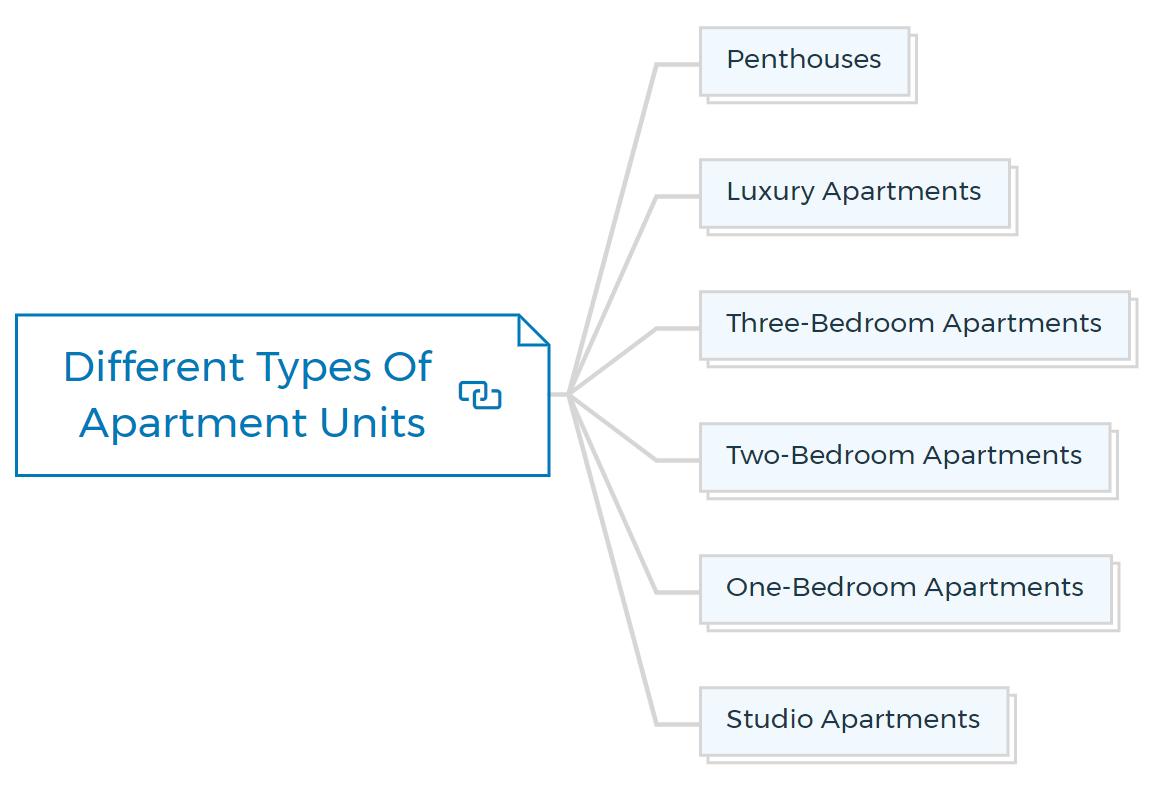
Penthouses
Usually found on the top floor and typically take up the entire floor.
Luxury apartments
With at least two bedrooms, two bathrooms, a study, and a floor area of more than 150 square metres, this design appeals to the executive.
Three-bedroom apartments
These buildings are primarily for growing families, internal floor area 100 square meters to 150 square meters.
Two-bedroom apartments
For singles and married couples, with one or two bathrooms and internal areas ranging from 70 to 90 square metres.
One-bedroom apartments
These are primarily for singles and young couples, with 50 to 65 square metres of interior areas.
Studio apartments
Often known as bedsitters, are designed for singles who want to live alone and have a minimum area of 40 square metres.
Parking facilities for these various types of flats depends on two factors: first, local council requirements, and second, market considerations. If the apartment development's location does not have adequate public transportation, a minimum of one parking space per apartment may be required.
If the site is near a transportation centre, parking will be easier to come by.
The mix of units will depend on the developer's and team's market and demographic study.
Demand for apartment living
Several factors have influenced the types of houses added to housing stock over the last decade. Changes in the population's age structure, household and family composition and size, and the need for lower-cost housing and housing closer to employment centres, have all influenced the demand for more variety in dwelling styles.
If you are still unsure about apartment developments, consider the stats of RealPage, the apartment demand in the USA in 2021 surpasses the previous high by 66%.
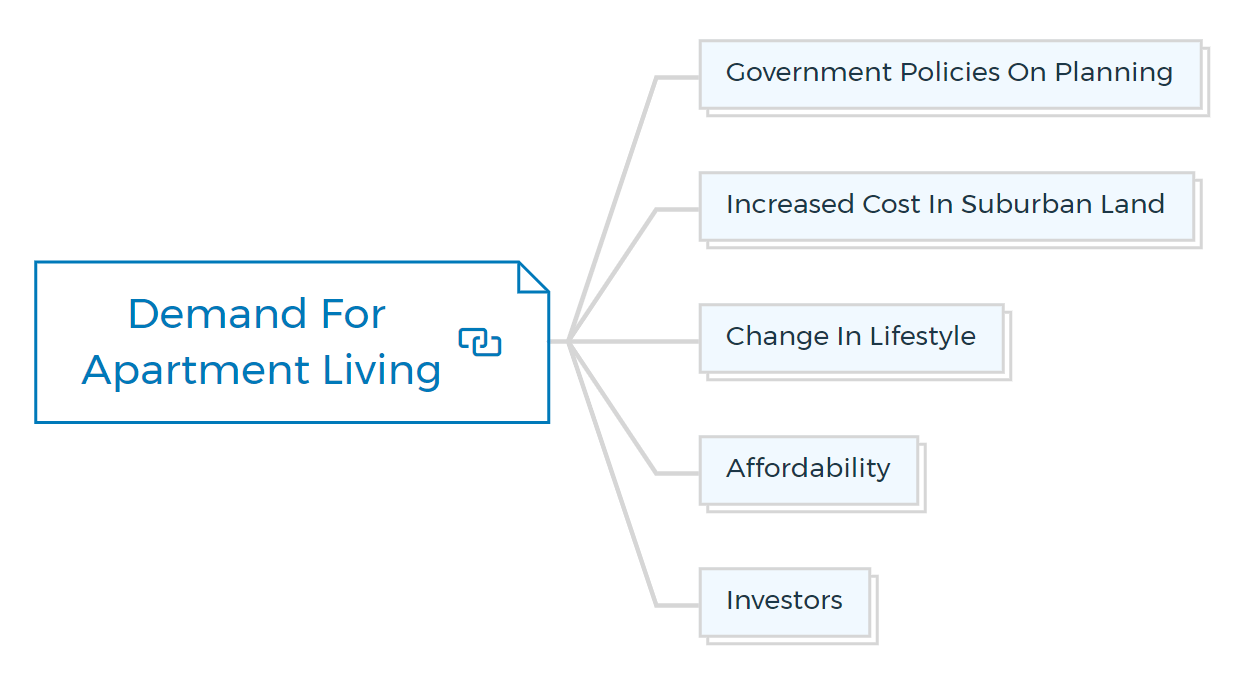
Government policies on planning
During this time, the government and urban planners have supported and encouraged more housing options, effectively boosting the availability of different types of higher density housing.
Other factors influencing this policy push for higher density housing include the rising cost of land in city centres, the infrastructure expenses of developing a non-urban territory, and environmental worries about urban sprawl.
Urban sprawl necessitates extra road infrastructure and public transportation, costing the government and taxpayers, making it unsustainable.
Increased cost in suburban land
Aside from the cost of raw land, subdividing land currently costs between $60 000 and $100 000 per lot. Property developers have a more challenging time absorbing unforeseen costs because of hurdles such as the government planning system's complexity, unclear time frames, and unpredictable expenses.
Lack of process transparency, inconsistent planning requirements across local government areas, and a lack of trust between local councils have emerged as significant roadblocks to negotiating the planning system. It also substantially impacted development costs, passed on to homebuyers.
Change in lifestyle
Life is changing rapidly. Households are contracting, and people are working longer hours, having children later, and having less time for other activities. These changes imply that being close to cafes, shopping, transportation, and other lifestyle amenities is more important than having a large backyard for the dog and extra bedrooms for the kids.
Furthermore, after their children have moved out, baby boomers are increasingly looking to sell their large, high-maintenance four-bedroom homes and move into smaller, lower-maintenance lock-and-leave flats near amenities, shops, and café strips.
Affordability
According to a housing affordability report of the Australian Institute of Health and Welfare, the availability of rental apartment real estate properties increased in various capital cities, resulting in a decrease in median rentals for inner-city flats.
Between the first and third quarters of 2020, median rents in the north and west Melbourne fell by roughly 5%. Sydney experienced a ten per cent drop. As demand rises for new developments that provide luxury living at low rates (solving Australia's growing population problem), developers are building smaller units to keep them affordable, leading to higher interest in Apartment Development.
Investors
Investors are buying apartments near amenities due to the increase in the rental market. Negative gearing and capital gains tax reductions are among the many advantages that encourage housing investment, with one in every seven taxpayers now owning one or more investment properties.
Investors from other countries are contributing to the demand in several expensive countries.
Benefits, drawbacks, and challenges in apartment development
Compared to other forms of developments, apartment developments have the following advantages:
- Higher plot ratios represent more building to land value, resulting in more effective land use.
- High-profit margins as a reward for entrepreneurial endeavours.
- Because of the repetitive construction, less sophistication is necessary.
- Various sizes and budgets, ranging from one to three bedrooms, are available to satisfy a wide range of buyers.
- Because of the location and attractions, there is a large rental market.
- If well-located and well-designed, there is a good resale market.
- Long-term investing requires reasonably constant financial flows.
- Depreciation write-off is quick, and there's a lot of tax shelter here.
Large apartment complexes may have advantages over smaller apartment buildings in terms of lower per-unit operating expenses (owing to scale economies) and ease of rental due to additional amenities (pools, tennis courts).
A report by CNBC stated that apartment occupancy in the USA hit a new record of 97.5%. The rate is around 250 basis points higher than the long-term norm of approximately 95%.
Apartment development, on the other hand, may have some drawbacks:
- A lack of complete market analysis, such as of consumer needs.
- The inability of consumers to pay expected sales prices or rents.
- Competition from other projects, both present and in the planning stages.
- A site or area that is improper.
- Community objection to the apartment building.
- The project faces funding challenges because the developer lacks a track record or experience.
- Increased time, talent, and financial demands.
- Exposure to government regulations.
- There are no long-term tenants and no significant tenants to bankroll the project.
The developer must overcome the following obstacles to be successful in apartment developments:
- Obtaining sufficient working capital.
- Preparing for long-term obligations.
- Constructing or contracting for specialized financial and asset management expertise.
- Gaining a broad understanding of the housing market in the short and long term.
- Managing a vast development team that includes both employees and contractors.
- Battling community and political resistance.
- The accessibility of viable and cost-effective building sites.
- Recognizing and dealing with complex laws and regulations.
6 Major considerations for building an apartment successfully
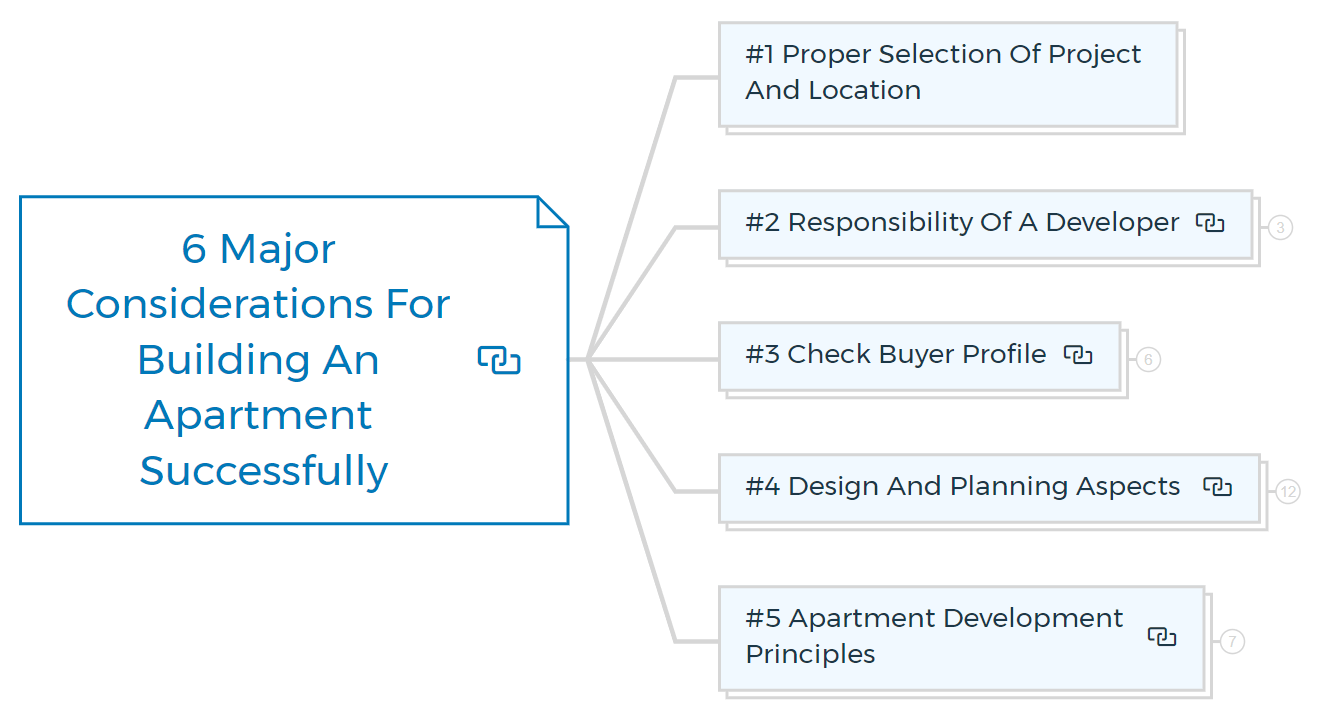
#1 Proper selection of project and location
The size and location of an apartment construction project are essential factors. The intended project scale depends on available cash, market demand, lender attitudes, site constraints, and the developer's ability to take risks and manage operations at various project sizes.
The location may be a matter of opportunity or personal preference. If the terms are fair and the place appears practical, experienced developers will frequently seize an available option. When you choose, it's a good idea to weigh your options before deciding on a location.
The ideal location should be large enough to handle a project of the appropriate size and in a neighbourhood or area that will appeal to potential buyers willing to pay the price.
In addition, the apartment development site should provide the following features:
- High level of visibility
- Optimum soil conditions
- Excellent drainage
- Services availability.
- Pleasant environment and surroundings
- Proper exit and entry
- Distinguishing amenities
- Public transportation and shopping Access to eateries and entertainment facilities
- Public parks and other communal facilities are accessible.
Within a reasonable amount of time, the required zoning should be in place or available. Environmental or other development constraints should not be overly stringent.
The site should be accessible on terms that allow the developer the most latitude to study the location before investing substantial sums of money, preferably under an option agreement that you can extend if necessary.
#2 Responsibility of a developer
A new developer considering apartment development as a long-term business should consider their long-term ambitions and available resources. They must be aware of two significant external constraints to their objectives: the availability of suitable development sites and their financial resources.
Because most apartment buildings require more money and time than smaller villa developments, developers can choose from one of three roles, depending on their financial situation.
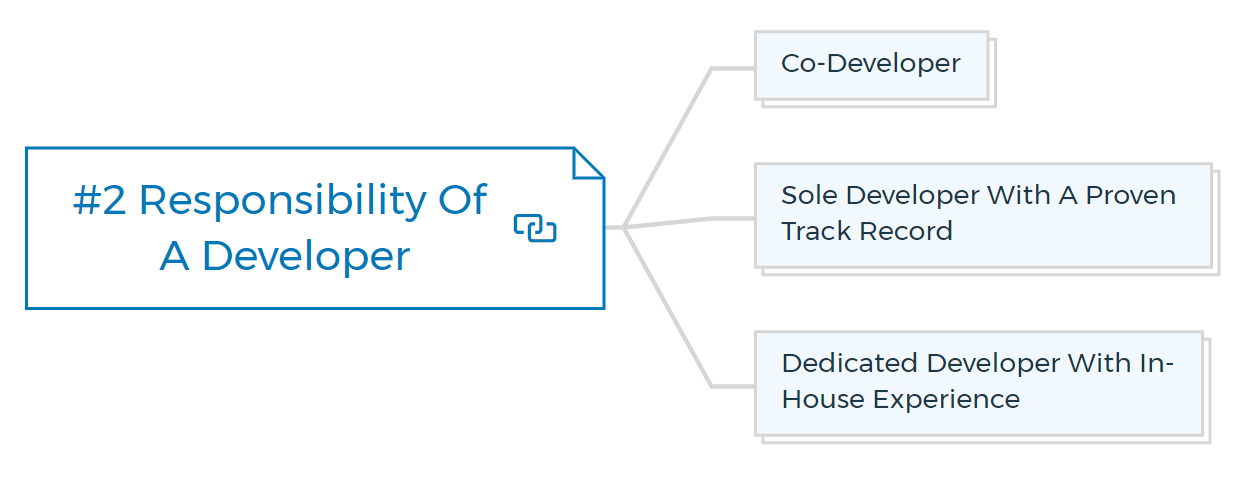
Co-developer
This structure necessitates the least amount of personal involvement and time. It's a great place to start for a new developer who wants to learn about apartment construction from a seasoned pro with a proven track record.
It delegated most of the day-to-day development tasks to a seasoned programmer. By collaborating as a co-developer, the inexperienced developer can contribute one or more of the following resources to the project:
- A combination of cash and up-front development funds
- Equity for land purchases.
- A solid financial balance sheet
- A wide range of business experience and contacts
- Enduring ties with other possible investors
Sole developer with a proven track record
The experienced property developer with a track record works independently in this development paradigm but is often surrounded by independent and informed consultants. This developer is in charge of the following responsibilities:
- Locating land and assessing the project's viability.
- Collaborating with a group of reputable advisors.
- Organizing all financial aspects.
- Collaborating with potential investors and silent investors.
- Taking care of all economic and cash flow requirements.
- Handling the project on behalf of the investors.
Dedicated developer with in-house experience
The real estate developer in this model must have extensive technical knowledge and experience in tax, financial, legal, and building. The concept also necessitates an ongoing apartment development commitment to justify the high administrative expenditures.
This developer is a private or public corporation that has made apartment construction a long-term business. This developer:
- Identifies and acquires potential development projects
- Has a design and estimating team
- They have a construction section that handles all work
Has a financial division that uses a fund or a syndicate to raise equity capital from investors.
How To Finance Your Property Development Project?
And Other Books On
Real Estate Development Finance
Includes 5 x detailed eBooks

✓ Property Development Finance: Easily Finance Your Project? (26 Pages)
✓ 10 Big (Financial) Property Investing Mistakes Made By Investors (58 Pages)
✓ 10 Finance Options For Your Next Property Development Project (29 Pages)
✓ What Is Equity Finance And How Does It Work? (42 Pages)
✓ Property Investment Finance - Ultimate Guide
#3 Check buyer profile
There are different types of markets or buyers for an apartment building.
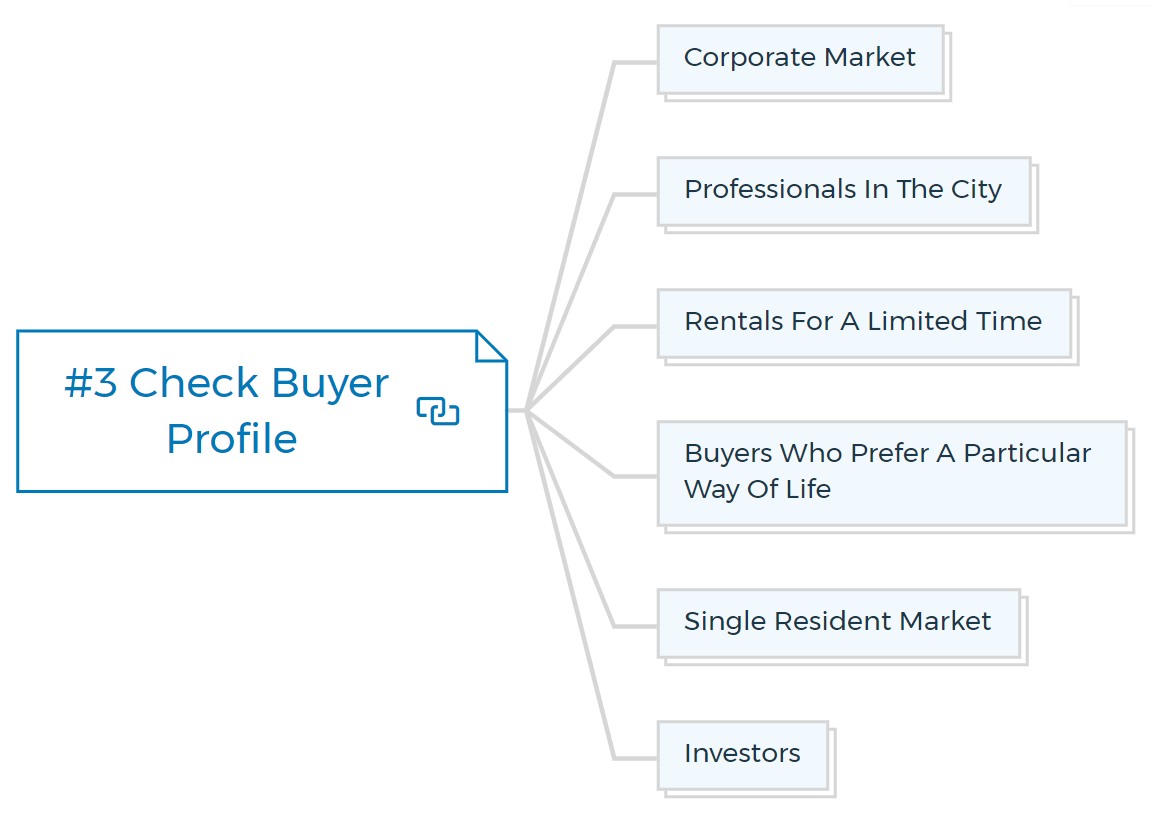
Corporate market
A corporation or an interstate company will usually be willing to spend a much higher price or rent for the apartment they want because it will still be less expensive than providing hotel accommodations for an employee.
For appealing to the corporate market, an apartment should be a modern-styled building with comprehensive security, located within a few minutes' walk of the inhabitants' workplace, and fully serviced.
The optimum size for this market is in the CBD, within walking distance of their workplace.
Professionals in the city
Professionals in the city are increasingly choosing to reside near their workplace. These folks choose a city lifestyle, which includes cafes, high-quality restaurants, and a vibrant nightlife, over accommodations.
The finishing quality is more significant than the space available, and the location is also crucial. Competent developers will build as close to essential office towers and city living amenities as possible.
Rentals for a limited time
Short-term rentals or short-stay accommodations obtain much higher rental than longer-term residential rents for tourists and business travellers. The building should be completely furnished and well-managed to attract such renters.
The developer's plan in creating such apartments would be to either hold the property as a long-term investment or sell specific apartments to offset some of their financing costs while keeping the rest.
Buyers who prefer a particular way of life
Young professionals, semi-retired couples, and empty nesters all appreciate the idea of living in a building that caters to their specific needs. Common area amenities such as a gym, swimming pool, view terraces, and concierge service can help to create a lifestyle.
Single resident market
Unmarried or divorced people who live alone seek out one-bedroom apartments, studio-style apartments, loft-style flats, or bedsitter-style apartments.
The style of the building isn't essential, but the price and rental should be reasonable, and there should be restaurants and entertainment nearby.
Investors
Investors might purchase an apartment for the short or long term. When it comes to the former, the investor usually buys off the plan in the hopes of reselling the unit at a higher price once it's finished.
The long-term investor purchases as part of their property portfolio or purchases and rents for a length of time till they eventually occupy the building in their older years.
#4 Design and planning aspects
The developer's architect should know the following design factors to guarantee a cost-effective and market appealing apartment complex.
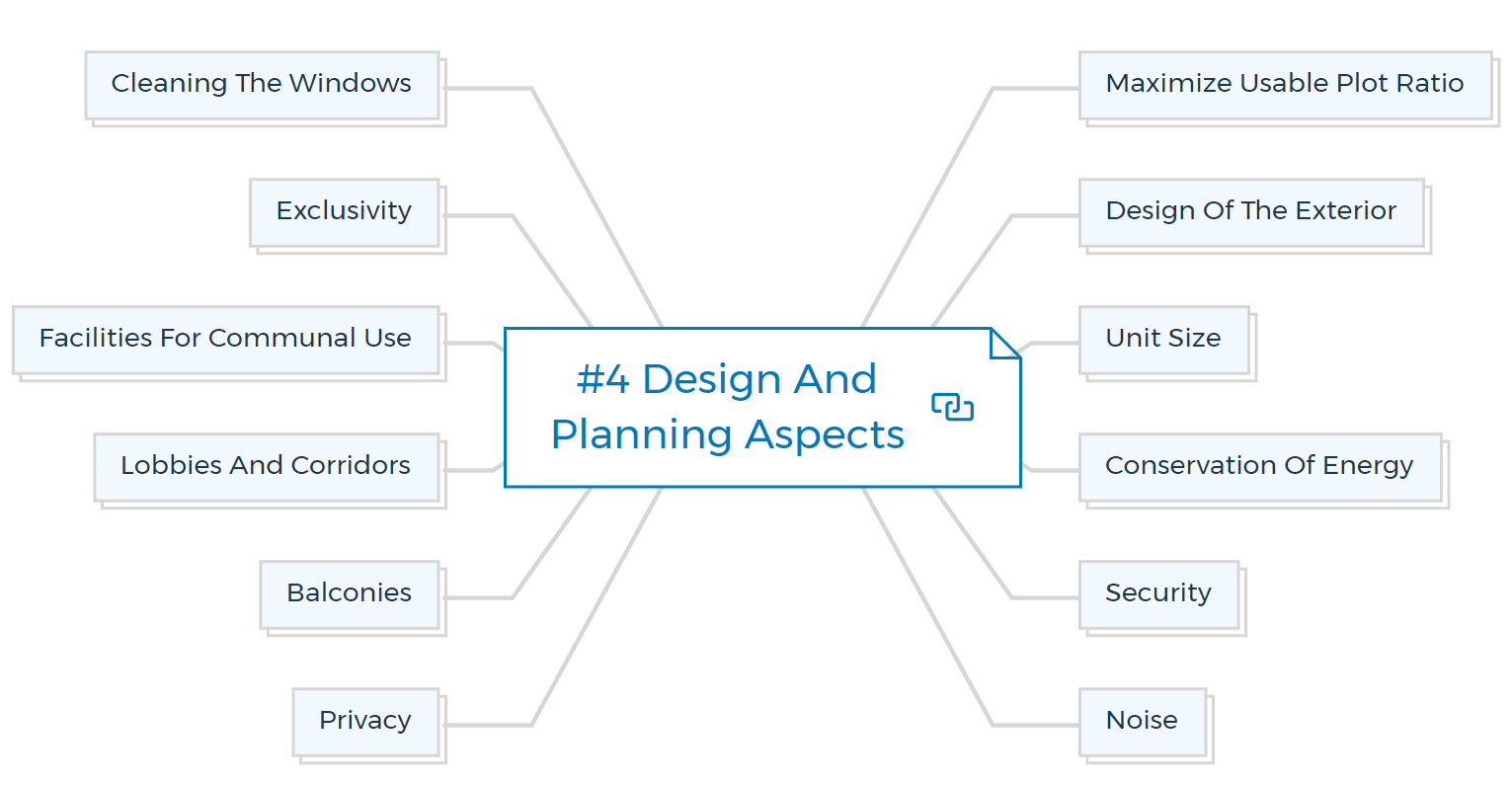
Maximize usable plot ratio
The liveable square metres per site area is the usable plot ratio. For example, if the site is 1000 square metres and the plot ratio is 1, you can construct a habitable space of 2000 square metres. The usable area doesn't include public corridors, stairways, lifts, mechanical and electrical rooms, storerooms, balconies.
While maximizing the available plot ratio is preferred, this may not always be the case. For example, some markets may require at least one parking bay for each unit, even if it is not a municipal requirement, resulting in a second, more expensive multi-level parking space.
Design of the exterior
A property's design must match or exceed the surrounding properties to stay competitive in the marketplace. External facade treatments like feature stone and glass balustrades can assist attract buyers by creating a point of difference, while you can recoup the extra expenditure in the sales price.
You should use non-maintenance or low-maintenance material because multi-level building maintenance might be costly in the long run.
Unit size
Measure the size of every unit in residential property to ensure that it meets market requirements. In today's market, one-bedroom apartments with 100 square metres are unattainable.
For financial reasons, there is a shift from three-bedroom flats toward two-bedroom plus two baths, two-bedroom plus one bathroom, and one-bedroom plus one bathroom.
Check if the unit mix in each size fulfils current market demand. There will be a potential marketing challenge if the property only provides two-bedroom apartments in a market requiring one bedroom.
Conservation of energy
Given the high energy cost, developers will need to assess the utility system for the development and the energy conservation strategies employed. Solar orientation, wall insulation, double glazing, solar panels, and low voltage light fittings, for example, should all be taken into account.
Before specifying, check the energy efficiency of appliances to make sure they are in good working order.
Security
People who move into apartment buildings are concerned about their security. Entrance from outside through windows or balconies is less likely than in a two- or three-story townhouse complex because most apartments are well above ground.
However, because public areas such as underground car lots, lobbies, lifts, and corridors are anonymous surroundings, intruders are more likely to go unreported as the building's population grows.
Consider security solutions in public spaces and parking areas, such as electronic keying systems with video or voice access and closed-circuit television (CCTV).
Security personnel may also be patrolling or limiting entrance to the building, depending on the security dangers in the area and the scale and cost of the development.
Noise
You will find most apartment buildings in noisy areas, such as on major transportation routes. Traffic noise is a standard component of their environment.
While most residents are accustomed to this noise level, noise from adjacent neighbours would be objectionable. Minimize the noise transmission between units by design and material choices.
You can also plan to reduce external noise by double glazing. In areas where noise levels are high, an acoustic engineer will aid in finding solutions.
Privacy
In apartment buildings, occupant privacy is vital. When designing the development, the architect should ensure that each unit has privacy by placing windows or balconies away from the neighbours' bedrooms, bathrooms, living areas, or outdoor spaces.
If this isn't possible due to design constraints, privacy screens or opaque glazing can be strategically installed.
Balconies
The tenants of apartments above ground level have no access to the ground; thus, a balcony becomes their sole private outdoor living space. Patios should be large enough to accommodate tables and chairs and an outside setting.
Provide a balcony measuring 3.5 metres by 1.8 metres as a bare minimum. Some local governments have mandated that each unit have a minimum area of 10 square metres.
Lobbies and corridors
Lift lobbies, corridors, and tunnels to the various units can positively or negatively impact the new apartment development. These places should be adequately illuminated and ventilated, especially with natural light. Public spaces that are dark and dingy are ugly and unhealthy.
Facilities for communal use
The quantity and type of communal facilities provided in an apartment complex will depend on the building's size, kind, and occupants' lifestyle. You can include a swimming pool, a gym, and a spa.
However, great thought should be given to the design of these amenities, as they are expensive objects to build and maintain in the long run, adding to the strata levies.
Exclusivity
Apartments built in a competitive location should offer customers something unique to give them a marketing edge. It could be something as simple as a unique architectural style, improved social facilities, views or vistas, or the most advanced technical equipment or appliances.
While it is essential for developers to maximize the number of units in a new project, they should not sacrifice quality in the process.
Cleaning the windows
Cleaning the exterior of windows in higher-level residences is difficult unless they face the balcony or have a cleaning ledge. During the planning stages, think about how someone will clean the windows. There are pivoting windows with specifically constructed openings to clean the outer area.
#5 Apartment development principles
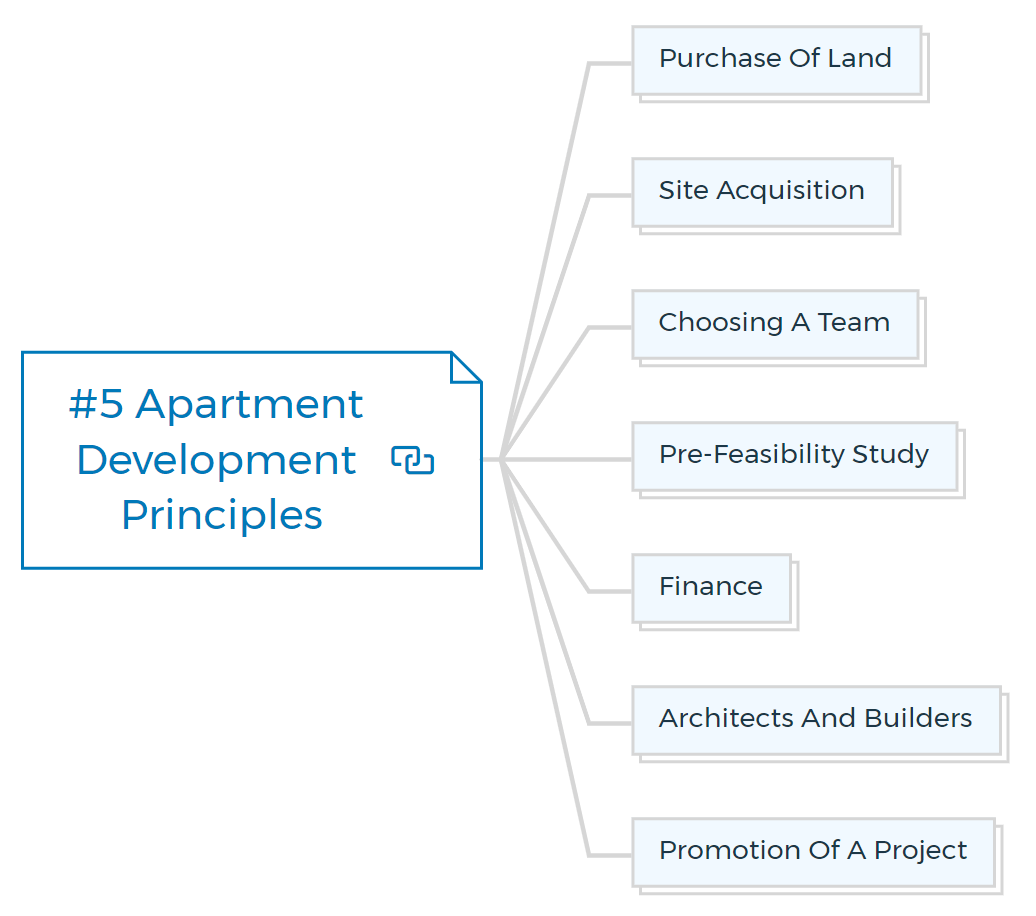
Purchase of land
The developer should conduct residual land analysis before purchasing a potential apartment development site. This land analysis should include determining how many apartments the site can accommodate and the average sale price for an apartment in the area and deducting risk profit, professional fees, construction costs, marketing, and interest, among other things.
Site acquisition
When scanning the site, the developer should look for the following information:
- Examine the vehicular access and egress to see if it is secure. Consider how the waste collection will work, as large refuse trucks require a lot of space to collect.
- Examine the soil conditions, mainly if someone previously used the land for industrial purposes. Environmental and remedial work may be necessary.
- Take a look at the site's gradient. A sloping site can be advantageous for an apartment project as you can use the lower floors for parking beneath the structure.
- Examine the charges for headwork. The cost will rise as the density and quantity of people consuming utility services rises, especially if the site is far from current utilities.
The preceding list outlines some potential places to consider. The developer should go to the site with consultants to see any further issues. You can take help from my detailed site acquisition guide.
Choosing a team
Working with a broader team of advisors, such as lawyers, accountants, architects, and experts in financing and deal structuring, is common in apartment development projects.
The developer will require the collaboration of specialists in design, construction, legal, property management, and financing. Long-term success is more likely with capable employees who work well together.
The work involved in putting together this type of residential construction is quite complex, and even the most seasoned developers recognize that there are no shortcuts and will seek professional help from the top consultants.
Good consultants are:
- Well-known in their neighbourhood or on a regional or national level
- A well-capitalized and experienced firm
- Previously successful in their development efforts
Pre-feasibility study
I've previously covered a comprehensive feasibility study guide that you should use in apartment development. The essential considerations for pre-feasibility analysis for apartment development should include expenditures unique to the apartment project's location.
These expenses may include:
- Local health, zoning, building, and environmental standards.
- Improvements to the existing infrastructure will necessitate a developer's involvement.
- Restrictions on waste disposal
- Maintenance requirements for elevators
- Sprinkler systems and other fire fighting equipment.
- Certificates of occupancy and building compliance
- Taxes and business licenses
- A cost of supplementary liability insurance
Additionally, calculate cash flows during the development phase carefully. To determine the highest cash drain, you should compute these on a month-by-month basis, from the start of the project through the settlement of sales.
Budgeting enough reserves can help to reduce long-term financial risk. Banks and investors frequently demand six months' worth of debt service and operational expenditures as operating reserves. As a result, the cash flow analysis should account for this reserve or contingency.
Finance
With pre-sales to the debt value, banks and lenders would finance 75 to 80 per cent of the TDC (total development cost) or 60 to 65 percent of the ultimate value.
With more developers joining the apartment market and growing demand for innovative financing, finance options are available that help a developer keep the majority of the earnings or expedite the pre-sales process.
Mezzanine funding is an option for developers who are confident in their idea but do not want to take on investment partners or dilute their shareholding. You can use Mezzanine financing as a second mortgage following the senior debt.
On the other hand, Mezzanine financing has higher interest rates and upfront costs. A developer that wishes to use mezzanine capital should compare this funding to investor equity.
There are financing and insurance businesses designed to underwrite the resale requirement on the presale market. Although the fee for this project is relatively high, it will aid in the development process.
Architects and builders
Quality control for apartment construction is another critical development issue, in addition to securing a fixed-price contract. Buyers can distinguish between good and bad quality.
The first customers might be the most effective marketing tool for the developers. As a result, choosing the cheapest builder or one with a poor reputation for quality work could be disastrous for the project and the developer's future career.
Finishes are the most crucial aspect of apartment quality control since they are what consumers perceive first and foremost. The importance of attention to detail is a priority. The developer's team should conduct regular quality-control inspections throughout the building process and increase this emphasis throughout the finishing process.
Promotion of a project
Suppose a condition of construction financing is that the developer must obtain a particular proportion of pre-sales before a bank allows cash to the project. In that case, the developer must hire the best project marketing team.
The developer must identify a professional project marketer with extensive industry expertise who can design a marketing strategy and team to pre-sell the development. The majority of project marketers would prefer a one-of-a-kind mandate or contract.
Having an agreement is excellent for a smaller project, but the developer should seek at least two organizations to establish a competitive environment for a larger project.
Because many apartment buyers are younger, it's essential to learn about a project marketer's track record, investor or buyer database, and whether they're using all of the latest marketing technology platforms, such as Facebook and blogs.
Final words
Apartment construction is demanding and challenging, but it may also be beneficial when the timing and market circumstances are right. Attractive interest rates, an elderly baby boomer market requiring less upkeep but more luxury, and a booming economy are all current market factors that favour apartment development.
Successful apartment buildings include waterfront views and easy access to facilities. Although demand for suburban homes will remain robust in the future, there is a clear trend in our cities toward apartment living.
Some individuals will still want to move to the outskirts of town to buy a house with a yard, but more are opting to live close to work, which usually means living in an apartment. Because of this firm and growing demand, apartments constitute excellent investments, providing higher capital and rental growth than houses in the outskirts, and this trend is likely to continue.
You can also be in the list of successful property developers by enrolling for structured property development courses.
FAQs
Is owning an apartment building profitable?
Apartment buildings are usually sold based on their capitalization rate, which multiplies their revenue. You should sell your building for a profit if you raise the income by boosting rentals or decreasing expenditures.
Do apartments increase in value?
Yes. Apartments rise in value faster than other properties, which has been the case for the past few years, with a staggering 60 per cent gain in overall worth.

